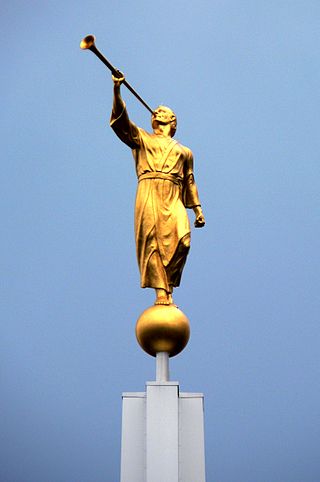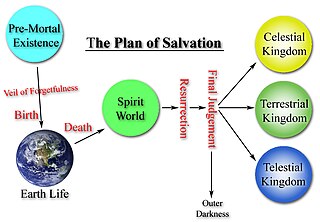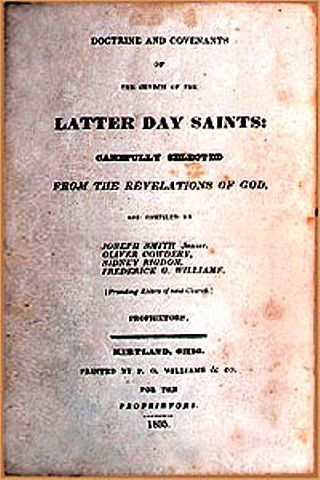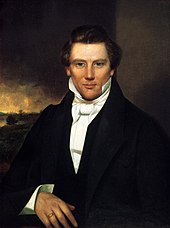
Mormonism is the religious tradition and theology of the Latter Day Saint movement of Restorationist Christianity started by Joseph Smith in Western New York in the 1820s and 1830s. As a label, Mormonism has been applied to various aspects of the Latter Day Saint movement, although there has been a recent push from the Church of Jesus Christ of Latter-day Saints to distance themselves from this label. A historian, Sydney E. Ahlstrom, wrote in 1982, "One cannot even be sure, whether [Mormonism] is a sect, a mystery cult, a new religion, a church, a people, a nation, or an American subculture; indeed, at different times and places it is all of these."

The Angel Moroni is an angel whom Joseph Smith, founder of the Latter Day Saint movement, reported as having visited him on numerous occasions, beginning on September 21, 1823. According to Smith, the angel Moroni was the guardian of the golden plates buried near his home in western New York, which Latter Day Saints believe were the source of the Book of Mormon. An important figure in the theology of the Latter Day Saint movement, Moroni is featured prominently in its architecture and art. Besides Smith, the Three Witnesses and several other witnesses also reported that they saw Moroni in visions in 1829.

The Church of Christ was the original name of the Latter Day Saint church founded by Joseph Smith. Organized informally in 1829 in Upstate New York and then formally on April 6, 1830, it was the first organization to implement the principles found in Smith's newly published Book of Mormon, and thus its establishment represents the formal beginning of the Latter Day Saint movement. Later names for this organization included the Church of the Latter Day Saints, the Church of Jesus Christ, the Church of God, the Church of Christ of Latter Day Saints, and the Church of Jesus Christ of Latter Day Saints.
The Church of Jesus Christ of Latter-day Saints has several unique teachings about Judaism and the House of Israel. The largest denomination in the Latter Day Saint movement, the LDS Church, teaches the belief that the Jewish people are God's chosen people and it also teaches the belief that its members share a common and literal Israelite ancestry with the Jewish people.

Blood atonement is a disputed doctrine in the history of Mormonism, under which the atonement of Jesus does not redeem an eternal sin. To atone for an eternal sin, the sinner should be killed in a way that allows his blood to be shed upon the ground as a sacrificial offering, so he does not become a son of perdition. The largest Mormon denomination, the Church of Jesus Christ of Latter-day Saints, has denied the validity of the doctrine since 1889 with early church leaders referring to it as a "fiction" and later church leaders referring to it as a "theoretical principle" that had never been implemented in the LDS Church.

Polygamy in the Church of Jesus Christ of Latter Day Saints, or plural marriage, is generally believed to have originated with the founder of Mormonism, Joseph Smith. According to several of his associates, Smith taught that polygamy was a divine commandment and practiced it personally, by some accounts marrying more than 30 women, some of whom had existing marriages to other men. Evidence for Smith's polygamy is provided by the church's "sealing" records, affidavits, letters, journals, and diaries. However, until his death, Smith and the leading church quorums denied that he preached or practiced polygamy. Smith's son Joseph Smith III, his widow Emma Smith, and the Reorganized Church of Jesus Christ of Latter Day Saints challenged the evidence and taught that Joseph Smith had opposed polygamy. They instead claimed that Brigham Young, the head of the Church of Jesus Christ of Latter-day Saints, introduced plural marriage after Smith's death. In 1852, leaders of the Utah-based LDS Church publicly announced the doctrine of polygamy.

The Pearl of Great Price is part of the canonical standard works of the Church of Jesus Christ of Latter-day Saints and some other Latter Day Saint denominations.

In the Mormon theology and cosmology there are three degrees of glory which are the ultimate, eternal dwelling place for nearly all who lived on earth after they are resurrected from the spirit world.
History of the Church is a semi-official history of the early Latter Day Saint movement during the lifetime of founder Joseph Smith. It is largely composed of Smith's writings and interpretations and editorial comments by Smith's secretaries, scribes, and after Smith's death, historians of the Church of Jesus Christ of Latter-day Saints. The history was written between 1839 and 1856. Part of it was published in Times and Seasons and other church periodicals. It was later published in its entirety with extensive annotations and edits by B. H. Roberts as part of a seven-volume series beginning in 1902 as History of the Church of Jesus Christ of Latter-day Saints.

Phineas Howe Young was a prominent early convert in the Latter Day Saint movement and was later a Mormon pioneer and a missionary for the Church of Jesus Christ of Latter-day Saints. Phineas Young was an older brother of Brigham Young, who was the president of the LDS Church and the first governor of the Territory of Utah.

The One Mighty and Strong is the subject of an 1832 prophecy by Joseph Smith, the founder of the Latter Day Saint movement. The prophecy echoes and parallels the words and prophecies contained in Isaiah 28:2 and Isaiah 11:11; 2 Nephi 3:21-25. The One Mighty and Strong was said by Smith to be one who would "set in order the house of God" and arrange for the "inheritances of the [Latter Day] Saints." Since the prophecy was proclaimed, many Latter Day Saints have claimed to be or to have otherwise identified the One Mighty and Strong. Some schismatic Latter Day Saint sects have arisen as a result of such claims.
In the theology of the Latter Day Saint movement, an endowment refers to a gift of "power from on high", typically associated with the ordinances performed in Latter Day Saint temples. The purpose and meaning of the endowment varied during the life of movement founder Joseph Smith. The term has referred to many such gifts of heavenly power, including the confirmation ritual, the institution of the High Priesthood in 1831, events and rituals occurring in the Kirtland Temple in the mid-1830s, and an elaborate ritual performed in the Nauvoo Temple in the 1840s.

Rex Floyd Rammell is an American veterinarian and perennial candidate for public office in Idaho and Wyoming.
In the Church of Jesus Christ of Latter-day Saints, marriage between a man and a woman is considered to be "ordained of God". Marriage is thought to consist of a covenant between the man, the woman, and God. The church teaches that in addition to civil marriage, which ends at death, a man and woman can enter into a celestial marriage, performed in a temple by priesthood authority, whereby the marriage and parent–child relationships resulting from the marriage will last forever in the afterlife.
The name of the Church of Jesus Christ of Latter-day Saints is derived from an 1838 revelation church founder Joseph Smith said he received. Church leaders have long emphasized the church's full name, and have resisted the application of informal or shortened names, especially those which omit "Jesus Christ". These informal and shortened names include the "Mormon Church", the "LDS Church", and the "Church of the Latter-day Saints".

Early in its history, the Church of Jesus Christ of Latter-day Saints had a series of negative encounters with the federal government of the United States. This led to decades of mistrust, armed conflict, and the eventual disincorporation of the church by an act of the United States Congress. The relationship between the church and the government eventually improved, and in recent times LDS Church members have served in leadership positions in Congress and held other important political offices. The LDS Church becomes involved in political matters if it perceives that there is a moral issue at stake and wields considerable influence on a national level with over a dozen members of Congress having membership in the church in the early 2000s, and about 80% of Utah state lawmakers identifying as LDS.

The Church of Jesus Christ of Latter-day Saints is a Christian church that believes in the Second Coming of Jesus Christ. Preceding these events, members believe there will be a series of apocalyptic events that will prepare the earth for Christ’s return. Some of these events align with scriptural prophecy while others originate from modern day and uncanonized revelation. These events have deep importance in the church, and members believe their role in them is crucial. By adequately studying religious text, adhering to the council from their leaders, and making necessary preparations, church members believe they will be ready for the imminent destruction to come.

!["Death on a Pale Horse" by the artist Benjamin West. Joseph Smith, June 15, 1844: "[the steamboat] Maid of Iowa come down the river about 2 or 3 o'clock While I was examining Benj Wests painting of Death on the Pale Horse which has been exhibiting in my reading room for 3 days." Benjamin West - Death on the Pale Horse - 79.33 - Detroit Institute of Arts.jpg](http://upload.wikimedia.org/wikipedia/commons/thumb/0/09/Benjamin_West_-_Death_on_the_Pale_Horse_-_79.33_-_Detroit_Institute_of_Arts.jpg/220px-Benjamin_West_-_Death_on_the_Pale_Horse_-_79.33_-_Detroit_Institute_of_Arts.jpg)















